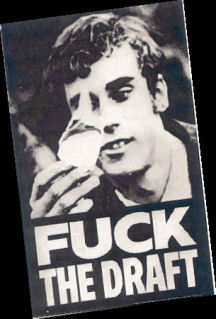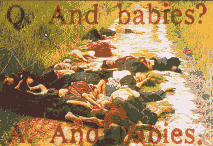Just as in other periods of contestation with the ruling order, not only did the Vietnam era resistance create its own periodicals, but it also published an enormous number of posters and flyers. Their subject matter didn’t only call for an end to the war, but denounced the U.S. empire and its armed forces, the police, racism, sexism, and many contained calls for revolution against capitalism.
They often did double duty being reproduced in the oppositional newspapers of the time. The Fifth Estate frequently displayed them on its back page and even as front cover images. Several are on display at the Fifth Estate museum exhibitions in Detroit.
So many posters and leaflets were produced at such a rate that it’s impossible to get a full count of the total number that were pasted on walls, stapled to telephone poles, and handed out in the streets.
“We have 2000 digitized posters in our archive,” says Julie Herrada, Curator, Joseph A. Labadie Collection at the University of Michigan, “and probably 3/4 of them are from the 1960s and ’70s. This number constitutes only a fraction of what was produced at the time.”
The Labadie poster collection is available for online viewing at http://quod.lib.umich.edu/l/lbc2ic.
Those who wrote the text and did the art were almost always uncredited, but two posters stand out in terms of mass circulation and the stories that accompany them.
Fuck the Draft
The hated military draft, administered by the Selective Service System, was the pipeline for forcing unwilling young men into the meat grinder of Vietnam. Before large numbers of recruits were called up, most opposition was comprised of individual resistance by faking medical conditions or being gay, or just disappearing. However, as coherent opposition to the war developed, sabotaging the draft became a high-importance strategy.
 Although the U.S. Congress had criminalized destruction of Selective Service cards with a penalty of a $10,000 fine and/or five years in federal prison, young men were inspired by the anti-apartheid mass pass burning protests in South Africa in the 1950s.
Although the U.S. Congress had criminalized destruction of Selective Service cards with a penalty of a $10,000 fine and/or five years in federal prison, young men were inspired by the anti-apartheid mass pass burning protests in South Africa in the 1950s.
At an anti-draft rally in Manhattan on October 15, 1965, David Miller, a member of the pacifist Catholic Worker movement, became the first man to burn his draft card.
From then on, it was cards ablaze!
“Fuck the Draft,” a large, 30 x 20 inch poster that first appeared in early 1968, was the creation of Kiyoshi Kuromiya, a Japanese American born in a U.S. internment camp in 1943. The use of the now common expletive in his denunciation of the draft was outrageous back then and led to an unsuccessful prosecution of Kuromiya for sending obscene material through the mail.
Most likely, his arrest had less to do with his choice of words and more because he offered the posters for $1 each or five for $5 with a sixth copy sent to the despised head of the Selective Service System in Washington, Gen. Lewis B. Hershey.
Undaunted, Kuromiya, free of the charges, printed up 2,000 of the posters and distributed them at the tumultuous 1968 Democratic Party convention in Chicago. Today, collectors ask $500 for original copies.
The photograph on the poster is that of a Detroiter who, purely coincidentally, was a high school classmate of Fifth Estate founder, Harvey Ovshinsky.
Kuromiya was a civil rights and gay rights activist who worked closely with Martin Luther King Jr. in the mid-sixties and took care of King’s children following his assassination. He was a founder of the Gay Liberation Front-Philadelphia and led early efforts to promote AIDS awareness after his own diagnosis later in life. He died in 2000.
A large number of men took up the call to fuck the draft. On October 16, 1967, as part of a national Stop the Draft Week, over 1,000 men returned draft cards, and by the end of major U.S. military involvement in 1972, 600,000 men violated Selective Service laws. Only three percent of draft resisters were prosecuted.
While it is doubtful that a draft would ever be reinstated, all male U.S. citizens and immigrants, 18 through 25, are still required to register with the Selective Service. It is estimated that there are millions who are out of compliance with the law, mainly through failure to report a current address, but there are a substantial number of men who refuse or have failed to register.
“And, Babies.”
Rarely is the carnage of war perpetrated on civilians presented so graphically as in this poster which appeared at the end of 1969. The image is of the horrific 1968 My Lai Massacre, one of many such mass killings by U.S. troops in Vietnam.
 The dead South Vietnamese women and babies are overlaid with a question and answer: “Q: And babies?” and at the bottom, “A: And babies.” The quote is from a Mike Wallace CBS News television interview with a U.S. soldier who participated in the massacre.
The dead South Vietnamese women and babies are overlaid with a question and answer: “Q: And babies?” and at the bottom, “A: And babies.” The quote is from a Mike Wallace CBS News television interview with a U.S. soldier who participated in the massacre.
The poster was produced by the Art Workers Coalition (AWC), a group of New York City artists opposed to the war. The coalition included staff from The Museum of Modern Art (MoMA) which agreed to fund and circulate the poster, giving an idea of how deep anti-war sentiment was.
However, the MoMA Board of Trustees included New York governor Nelson Rockefeller, who soon would preside over a massacre of his own at Attica Prison in 1971, and the president of CBS, William S. Paley.
They both backed the Nixon administration’s war and quickly put an end to the museum’s involvement with the printing project. However, their attempt at squelching the poster had the opposite effect.
In an incredible act of solidarity, New York City’s Local One of the Amalgamated Lithographers of America printed 50,000 copies without charge. The poster gained national and international attention highlighting U.S. war crimes in Indochina.
Soon after, members of the AWC brought copies of the poster into the MoMA, and held them in front of Picasso’s painting, Guernica, on loan to MoMA at the time, which depicts the horrors of war and how innocent civilians suffer.
These two posters, among the hundreds, illustrate the power of art in combating wars of the empire.
Peter Werbe is a long-time Fifth Estate staff member and co-curator with Barbara Logan of the 50th Anniversary exhibition at the Museum of Contemporary Art Detroit.
